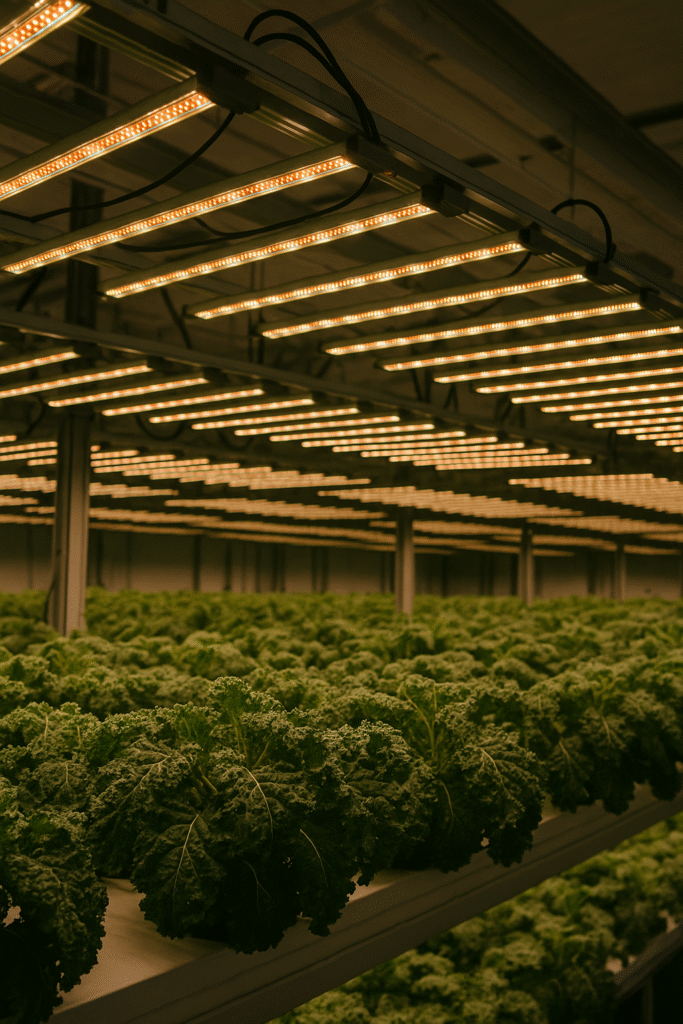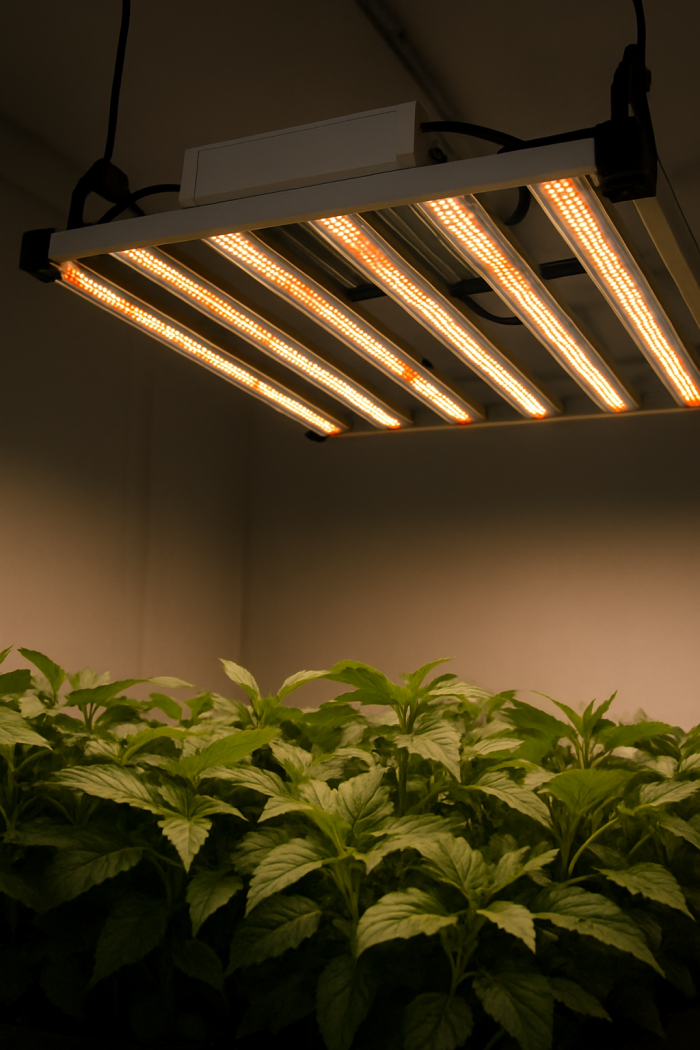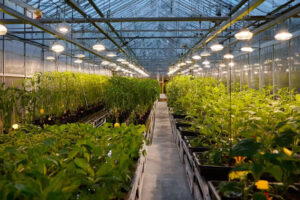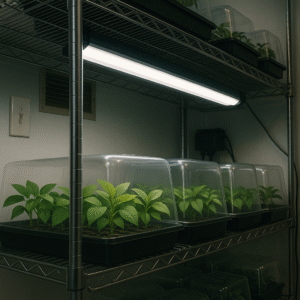
It is crucial to involve LED Grow Lights Rebate Solutions early in your project. The final cost basis of your lights interacts with rebate program structures in ways that aren’t obvious at first. For example, under-canopy LED grow lights and high-output overhead fixtures come in multiple footprints, and selecting the right combination has a major impact on efficiency, coverage, and rebate eligibility.
When selecting high-performance LED grow lights, spectrum quality is a critical factor. Different plant stages require different spectrums—blue light supports vigorous vegetative growth, while red light drives flowering and fruiting. Many advanced fixtures offer tunable spectrums, giving growers precision control to match crop stages and maximize yield. High-efficacy diodes and balanced full-spectrum output can dramatically improve crop quality and reduce wasted energy.

Understanding Light Coverage
Top-tier LED grow lights typically provide wide and uniform light coverage with high PPFD levels across the entire canopy. Larger fixtures often integrate advanced passive or hybrid cooling systems to manage heat without excessive energy use. This temperature stability extends the fixture’s lifespan and protects plant health, ensuring consistent performance over time.
Impact of Light Positioning
Proper light positioning is essential to fully leverage the performance of your LEDs. With under-canopy lighting, angle and placement must minimize shadows and deliver light evenly to lower plant regions. Adjustable brackets and hanging systems make it easy to fine-tune positions as plants grow. Hanging overhead fixtures too high wastes light; too low can cause stress or burn. Adjusting height dynamically by growth stage ensures optimal PPFD distribution and healthier crops.
Trends in LED Grow Light Technology
Many fixtures now include smart controls, enabling growers to manage intensity, spectrum, and schedules remotely through smartphone apps or cloud platforms. These innovations deliver both precision and efficiency.
Environmental Considerations
Top-performing LEDs don’t just boost yields—they also lower operational impact. By running cooler and more efficiently, they reduce HVAC loads and overall facility energy consumption. Many manufacturers now focus on eco-friendly materials and energy-saving designs, making performance lighting a key part of sustainable cultivation strategies.
Financial Aspects of LED Grow Lights
Before investing, conduct a thorough cost-benefit analysis. Consider installation costs, expected fixture lifespan, energy savings, and potential rebates. For example, if switching to LEDs reduces energy bills by 30%, the payback period shortens dramatically. Pairing high-efficiency fixtures with rebate programs can make advanced lighting financially attractive even at higher upfront costs.
Maintaining LED Grow Lights
Performance depends on upkeep. High-output LEDs should be cleaned regularly to remove dust from lenses, and wiring should be inspected to prevent moisture ingress or shorts. Routine checks help preserve light output, avoid downtime, and protect your investment in premium fixtures.
Case Studies on LED Grow Light Usage
Studies show that tomatoes grown under optimized LED spectrums grow faster and yield more than those under legacy lighting. Similar results are seen across leafy greens, strains, and specialty crops—high-performance fixtures consistently boost both yield and quality.
Future of LED Grow Lights
As plant science advances, LEDs are evolving to deliver precision light tailored to specific crops. Future high-performance models will integrate research on spectrum–plant interactions to push yields and quality further, while using even less energy per gram produced.
Community and Support Resources
Joining grower communities provides access to real-world experience with performance lighting. Forums and groups share practical tips, helping you stay ahead of emerging lighting technologies and cultivation methods.
Final Thoughts on LED Grow Lights
The right high-performance LED grow lights can transform your cultivation results. From spectrum tuning to intelligent controls, these technologies give growers powerful tools to optimize energy use and crop output. Staying informed, maintaining your fixtures, and leveraging rebates are key steps to long-term success.
Economics of Larger LED Grow Lights
Fixtures with larger footprints often deliver better economics per square foot. Fewer drivers and mounting points reduce hardware costs and complexity, while maximizing coverage with fewer units.
Ergonomics and Operational Efficiency
Larger under-canopy fixtures reduce handling time during harvest and cleaning. Fewer connections mean fewer potential failure points and faster turnaround between cycles, which is critical in commercial operations.
Insights from Commercial Growers
Large facilities consistently emphasize that picking the right high-performance light early pays off over the entire rebate and operational timeline. Reliability, spectrum, and controllability often matter more long-term than chasing the lowest upfront cost.
Regional Differences in Grow Lights Rebates
The most cost-effective fixture varies by region and utility program. In California, rebates may be paid per fixture; in that case, using smaller, high-efficiency fixtures can maximize total incentives. See PG&E Rebates & Incentives.
In Michigan, under Consumers Energy, incentives are calculated per watt installed. Here, larger high-efficiency fixtures may offer the best economics. See Consumers Energy Business Rebates.
Field-Adjustable Wattage Benefits
Fixtures with field-adjustable wattage allow growers to optimize electrical loads and tailor lighting strategies to both crop needs and rebate program rules. This flexibility can maximize both productivity and incentives.
Program Metrics and Compliance
Some rebate programs focus on wattage; others on PPFD, PPF, or PPE relative to baselines, such as California Title 24 Energy Code. In some cases, operating at higher wattages with efficient LEDs can actually increase rebates by boosting productive light output without expanding square footage.
Verification and Compliance Risks
Energy providers may audit actual energy use. If fixture performance or operation doesn’t match your application, rebates can be reduced or clawed back. Accurate planning and documentation are essential to avoid cashflow risks.
In conclusion, navigating rebate programs can be complex. We want you to succeed, so please contact us. Investing in the right high-performance LED grow lights can make a significant difference in both crop results and financial outcomes.









